Blog Archives
Peregrine Falcon in the suburbs
It was good to see this Peregrine Falcon perched high in a tree above the rooftops in Sydney’s Northern Beaches.
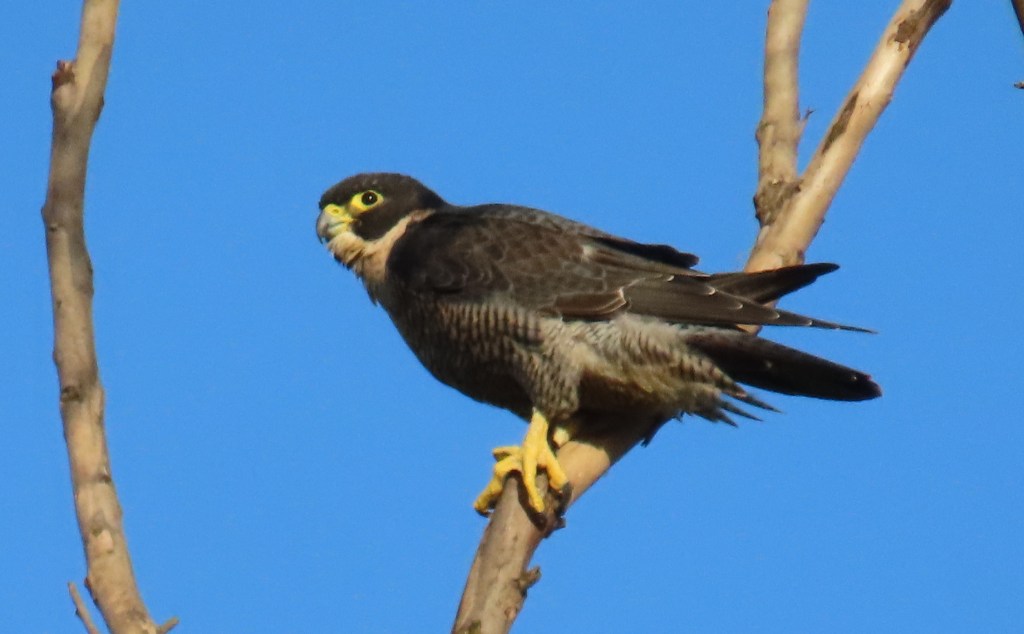
They’re beautiful birds, with that fierce eye and the contrast between yellow and black colouring. I’ve seen just a few Peregrine Falcons before, usually in a wilder setting. Check out the posts about my other sightings of Peregrine Falcons.
Common name: Peregrine Falcon
Scientific name: Falco Peregrinus
Approximate length: 42 cm
Date spotted: 15 February 2025 (summer)
Location: Allambie Heights, New South Wales, Australia. Approximate map reference: 33°46’18.2″S 151°15’39.4″E
Peregrine Falcon drops in to chat
This was such a wonderful experience! It was early one morning. I was strolling along the top of a cliff on North Head in Manly, and stopped to film some birds swooping around the cliff and the sea far below. To my surprise and delight, a Peregrine Falcon landed a few metres away and started calling.
You can see and hear the moment, at about 45 seconds into this video, when the falcon starts calling and the camera swings round to find it:
I don’t know if the birds swooping around the cliffs were Peregrine Falcons too. I suspect they were, as I heard their call, which came from a section of the cliff face that’s out of sight behind an outcrop. I’d been watching the birds for a while when one dropped in so suddenly.
The falcon stayed where it was, perched on a branch at the edge of the cliff, for a long time — at least 15 minutes. It was I who left in the end, not the bird.
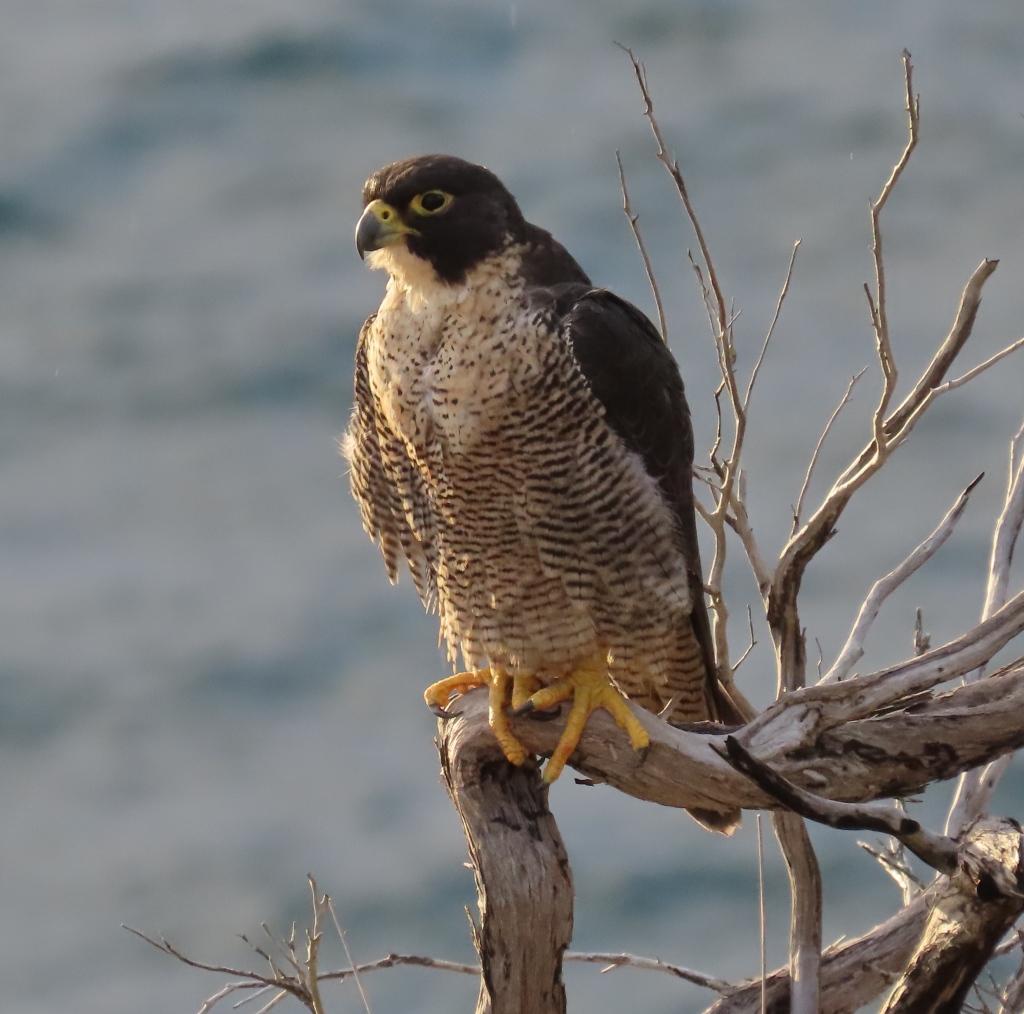
In the middle of a feather shuffle:
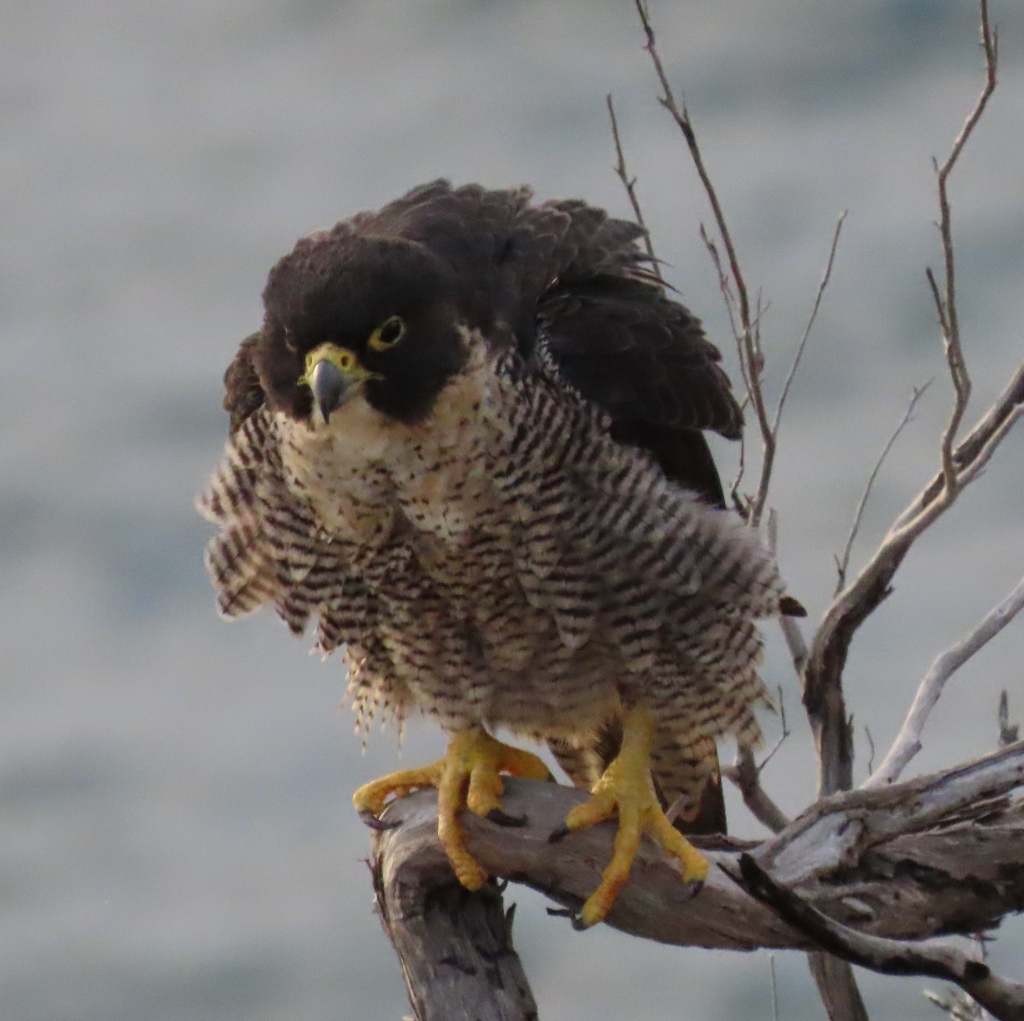
In the next video, the bird calls a few times (little chirps at the beginning; longer squeals at time stamp 1:02; squeals, hiccoughs, and chirps at 2:03; more at 2:35). It spends most of its time preening its feathers, which do seem to be in a bit of a state. Perhaps it’s a juvenile.
At about 50 seconds into the video, the view moves off the falcon to take in the ocean and the cliffs, but the bird calls attention back to itself quite soon.
At time stamp 2:16, both the falcon and I hear another bird calling overhead. The view wanders up into the sky to spot the other bird. Towards the end of the video, at 2:55, an aeroplane passes overhead and the bird quints up at it.
Although the falcon checked me out several times, it wasn’t in the least bit worried about me:

Common name: Peregrine Falcon
Scientific name: Falco peregrinus
Approximate length: 35-50 cm; wing span 85-100 cm
Date spotted: 7 May 2024 (autumn)
Location: Fairfax Track, North Head, Manly, New South Wales, Australia: 33°49’16.9″S 151°18’01.7″E
Three raptors in one day
A few days ago, I was super lucky: I saw three birds of prey in one afternoon. The first was an Eastern Osprey, holding a fish in its claws. The second was a Black-shouldered Kite, hovering above the grasslands near the beach. For a short time, there were two of these birds quite close to each other. The third was a Peregrine Falcon, soaring in the sky above the suburbs.
Eastern Osprey
The Eastern Osprey was exciting to see. It was quite large, flying high in the sky above Long Reef Aquatic Reserve in Collaroy. At first I thought this large bird was one of the pelicans that were floating about. When I saw it through my camera lens, I spotted the fish in the bird’s grip.
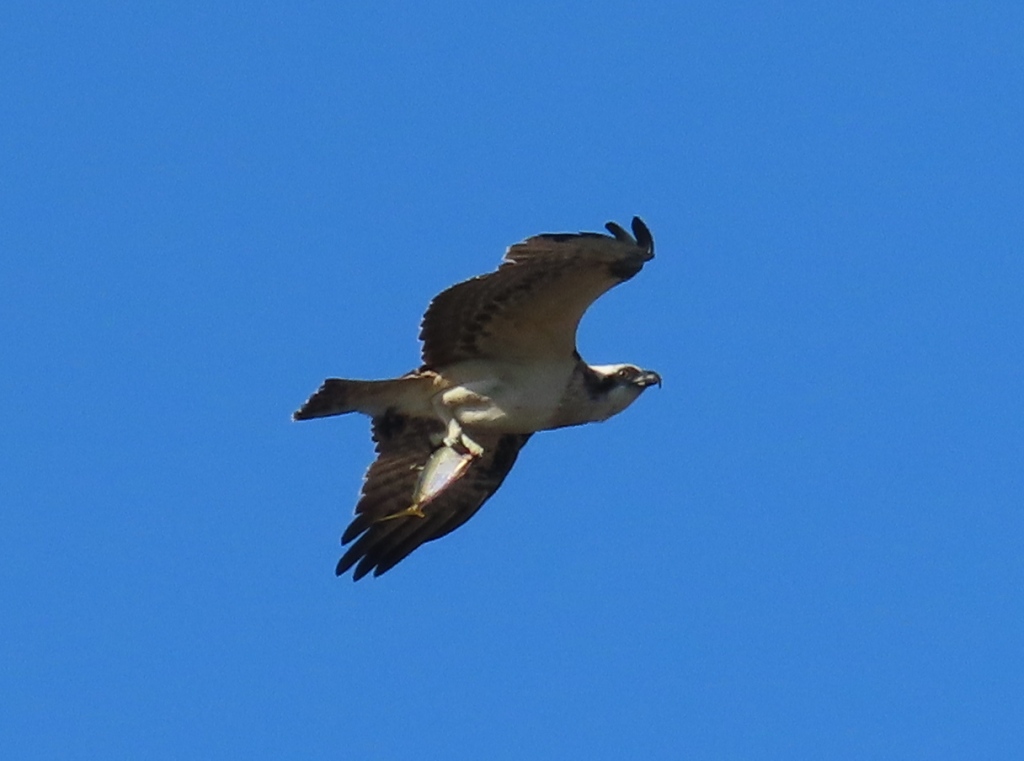
The next picture is fuzzy and only a partial shot of the bird, but it gives a good idea of the colouring of the underside:
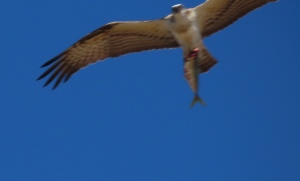
The next picture shows the Osprey’s long wingspan — about 1.5 metres. The bird is flying away from the camera:
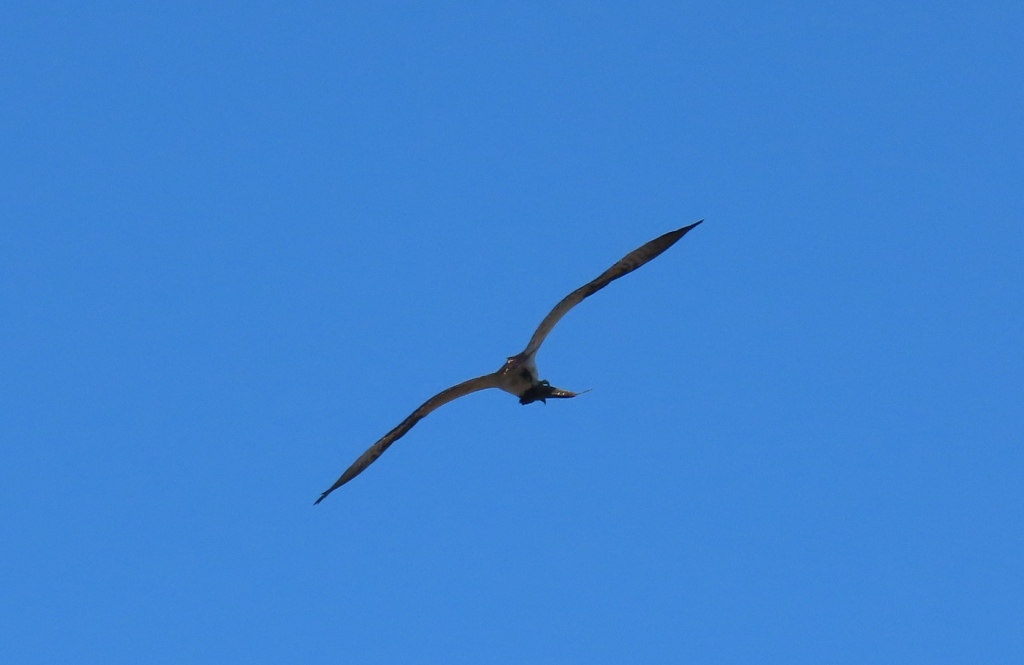
Common name: Eastern Osprey
Scientific name: Pandion cristatus
Approximate length: 57 cm
Date spotted: 24 March 2024 (summer)
Location: Long Reef Aquatic Reserve, Collaroy, New South Wales, Australia: 33°44’19.7″S 151°18’42.0″E
Black-shouldered Kite
Nearby, a Black-shouldered Kite hovered above the grassy, bushy stretch that runs along the coast. It was amazing how the bird hung almost motionless in the air, held aloft by the air currents:
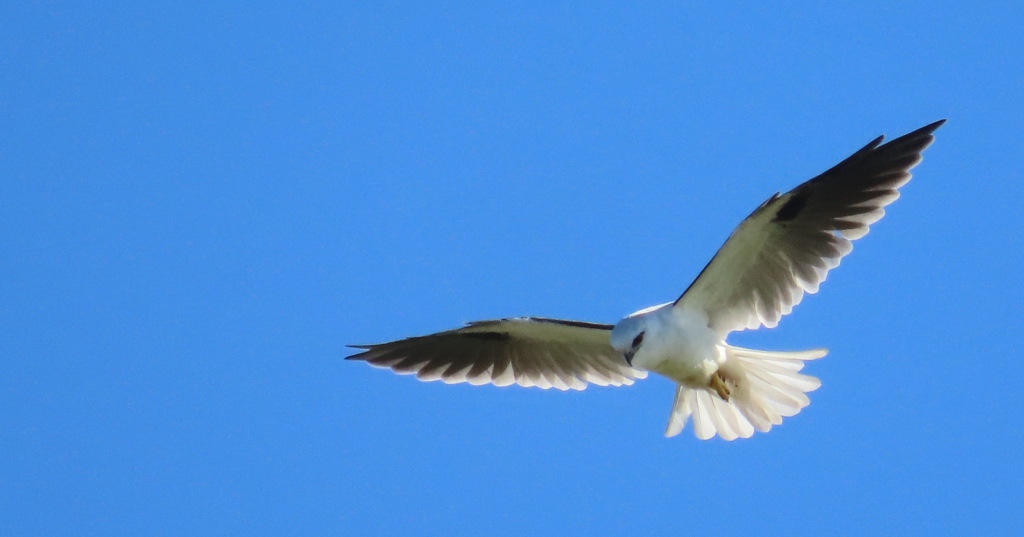
The next photo shows a slightly different angle. It might be the same bird or a different one, as there were two in the area:
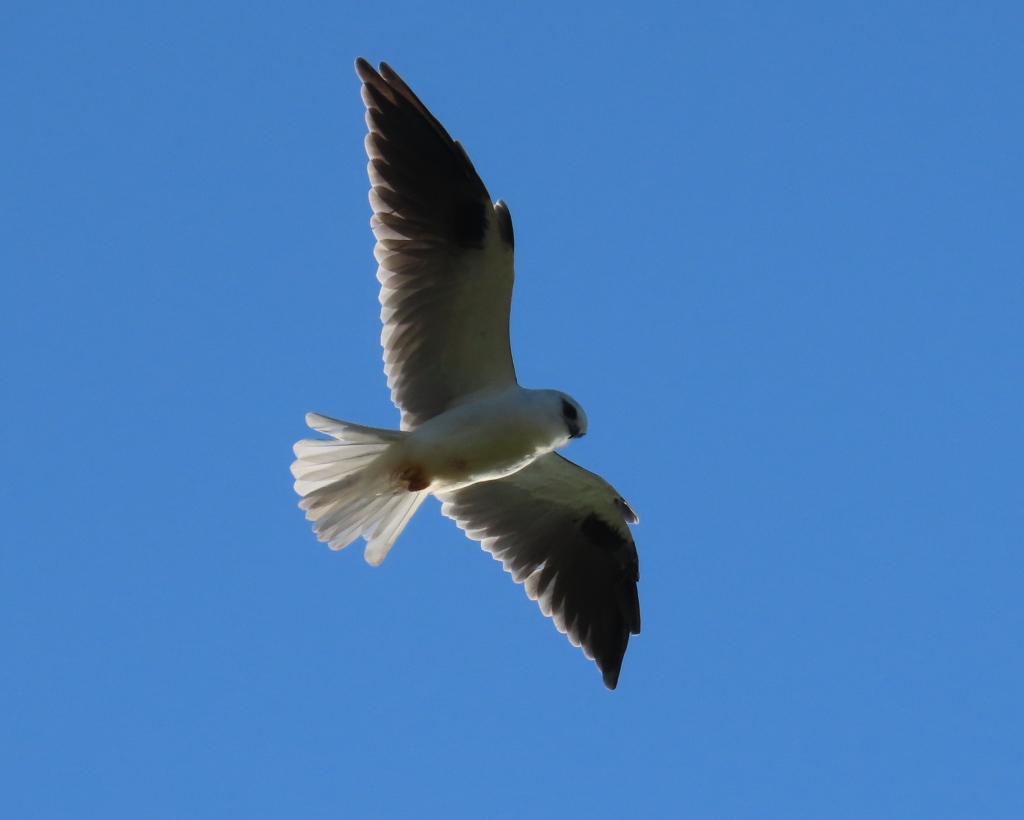
Also in the area were some paragliders, enjoying the same up currents as the birds. The gliders kept a respectful distance, and the birds didn’t seem worried at all, as you can see in the next video. The second Black-shouldered Kite makes a brief appearance part-way through:
Common name: Black-shouldered Kite
Scientific name: Elanus axillarus
Approximate length: 35 cm
Date spotted: 24 March 2024 (summer)
Location: Long Reef Aquatic Reserve, Collaroy, New South Wales, Australia: 33°44’19.7″S 151°18’42.0″E
Peregrine Falcon
On my way home, I saw a Peregrine Falcon soaring high in the sky. As I took the photo, the bird turned its head and looked down at me:

The images are fuzzy because my camera isn’t super powerful, but you can still make out the features of the Peregrine Falcon:
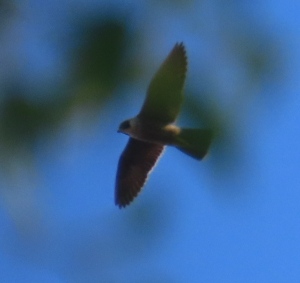
Common name: Peregrine Falcon
Scientific name: Falco Peregrinus
Approximate length: 42 cm
Date spotted: 24 March 2024 (summer)
Location: Allambie Heights, New South Wales, Australia: 33°46’18.2″S 151°15’39.4″E
It’s not often that I see one of Australia’s birds of prey. To see three different types in one day was a raretreat.
Peregrine Falcon at Dobroyd Head near Sydney
On an early morning walk at Dobroyd Head in Sydney Harbour, I spotted this beautiful falcon:

The bird sat quietly on a bare branch, observing the world from on high. I think it’s a Peregrine Falcon. My other choice would be an Australian Hobby, but the lighter-coloured collar doesn’t curve upwards as much as I’d expect in an Australian Hobby:

On the other hand, adult Peregrine Falcons in this area of Australia have a white collar. This bird’s collar is buff-coloured. It could be a juvenile bird, or it could be one of the buff-fronted form of Peregrine Falcon strayed all the way from Western Australia.
Both Peregrine Falcons and Australian Hobbies are uncommon, though widely distributed. The Peregrine Falcons are more rare than the Australian Hobbies.
Here’s another view of the falcon. Let me know if you think it’s an Australian Hobby rather than a Peregrine Falcon:

The bird was far away from me. Here’s a picture using less of my camera’s zoom. The falcon is perched on the bare tree to the right. To the left is another bird, most likely a Noisy Miner:

Birds of prey in Australia are often accompanied by a minder — another bird, usually a Noisy Miner, ready to sound the alarm if the hunter looks likely to hunt. This falcon was so peaceful that even the Noisy Miners were quiet!
Common name: Peregrine Falcon
Scientific name: Falco peregrinus
Approximate length: 35-50 cm; wing span 85-100 cm
Date spotted: 27 November 2022 (spring)
Location: Dobroyd Head, Sydney Harbour, New South Wales, Australia: 33°48’35.5″S 151°16’27.5″E



